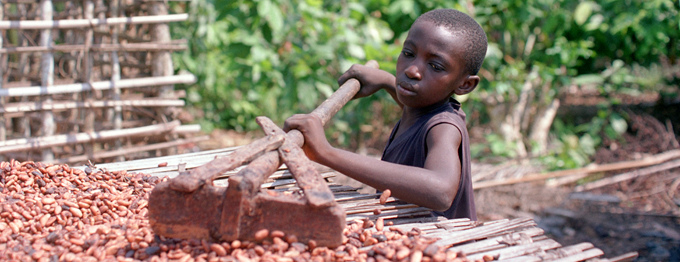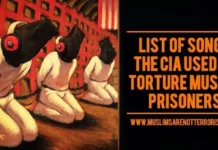
[responsivevoice voice=”UK English Female” buttontext=”Play”]
Children younger than 15 – some as young as 5 – work from 6 am till evening in West Africa at cocoa farms connected to Nestlé, Hershey, Mars, Kraft, ADM Cocoa, Godiva, and Fowler’s Chocolate to produce your favorite chocolates including Reese’s, Kit Kat, M&M’s, MilkyWay and Butterfinger.
In September 2015, three class action lawsuits brought in California accused Nestlé, Hershey, and Mars of turning a blind eye to human rights abuses by cocoa suppliers in West Africa while falsely portraying themselves as socially and ethically responsible. Nestlé, Cargill and ADM are currently facing a separate lawsuit brought by three Malian former child slaves in 2005 that accuses the companies of aiding and abetting child slavery in Côte d’Ivoire’s cocoa market.
The shocking 2000 documentary titled Slavery: A Global Investigation exposes the chocolate industry’s deep, dark connection to cocoa harvested by child slaves. The guardian of 19 children freed from slavery by the Ivorian authorities told the makers how they worked from dawn until dusk each day, locked in a shed at night where they were given a tin cup in which to urinate, stripped naked, tied up and routinely beaten. And how thousands of children were being purchased from their parents come from countries such as Mali, Burkina Faso, and Togo for a pittance, or in some cases outright stolen, and then shipped to Ivory Coast, where they are enslaved on cocoa farms.
To help you avoid supporting slavery, here are the 7 popular chocolate brands that exploit child slaves and benefit from child labor…
Nestlé
Although, Nestlé’s code of conduct prohibits the use of child labor in its supply chain, researchers from the Fair Labor Association found evidence of forced labor and children working for 14 hours in hazardous conditions doing dangerous tasks like using machetes and transporting heavy loads. A Nestlé spokesperson told The Guardian:
“To date we have identified 3,933 children working on their family farms (around 10% of the children surveyed) who were involved in hazardous tasks classified as child labor. We have included half of them in our Child Labour Monitoring and Remediation System, which includes providing school kits, obtaining birth certificates and developing income generating activities for the families of 312 identified children. Unfortunately, the scale and complexity of the issue is such that no company sourcing cocoa from Ivory Coast can guarantee that it has completely removed the risk of child labor from its supply chain.”
Nestlé posted CHF 91.6 billion in 2014 chocolate sales.
Hershey
The largest chocolate maker in the United States purchases the primary ingredient in its products from Ivory Coast notorious for worst forms of forced labor, human trafficking, child labor, and child slavery. In 2012, a Louisiana pension fund raised questions about Hershey executives’ knowledge of how much of the company’s cocoa, grown in West Africa, may have been produced by child slaves. Acknowledging the abusive practices, Hershey’s head of corporate communication Jeff Beckman told Confectionerynews.com:
“The allegations in the lawsuit are not new and reflect long-term challenges in cocoa-growing countries that many stakeholders, including NGOs, companies in the cocoa supply chain and the US Government have been working diligently together to address for a number of years.”
Hershey posted $847 million in net income in 2014.
Mars
In 2009, Mars committed to sourcing only certified cocoa by 2020. However, when Examiner asked Mars why it should take until 2020 to certify their chocolate child slave free, the company said that “a very small number of children is trafficked or forced to work on cocoa farms”, that “reaching every one of the millions of cocoa farmers in West Africa is a difficult task”, that ensuring non-child slave chocolate was “complex”, and that they believe “ten years is a realistic time frame” to ensure sustainability.
The Harkin-Engel Protocol, a cocoa industry-wide agreement was signed in 2001 to self-regulate and end child slavery in chocolate by 2005. That deadline was extended to 2008, and again to 2010. It’s 2016 and we still have chocolate manufacturers pledging to end child labor while raking in millions of dollars in profits off the abusive practice.
Meanwhile, a 2015 report found the number of children working in the cocoa industry had increased by 51% from 2009 to 2014 – now totaling 1.4 million. Those living in slave-like conditions increased 10% from the 2009 – now totaling 1.1 million.
Have a heart! Don’t buy chocolate from areas with the worst forms of child labor & slavery! https://t.co/hWKAffGr9l pic.twitter.com/DYYty46j5S
— Food Empowerment (@FoodIsPower) February 6, 2016
ADM, Kraft, Godiva, And Fowler’s Chocolate
In 2005, three Malian nationals who were forced into working on cocoa plantations in the Ivory Coast filed a class-action lawsuit in a federal court in California claiming that ADM, Cargill (in 2015 Cargill acquired ADM’s global chocolate business for an enterprise value of $440 million) and Nestlé — through purchasing cocoa harvested by child laborers — “aided and abetted” slavery, child labor, and torture.
As the decade-old lawsuit against ADM continues, one of the world’s largest processors of cocoa liquor, powder and butter sold its cocoa business for $1.3 billion in August 2015 to Olam International Ltd, a Singapore-based agribusiness company.
In 2012, Cadbury and Kraft Foods owner Mondelez International pledged $400 million to improve the lives of cocoa farmers and create a sustainable cocoa economy. But the efforts by the company, which has struggled for years to take forced labor out of its supply chain, have been ineffective so far.
More than 60% of the world’s cocoa, including Godiva’s, is sourced from West Africa. Unlike other major chocolate makers, Godiva has not made a commitment to trace its cocoa supply chain and work with locals to ensure it has not been harvested by child labor. Though it announced its committed to sustainable sourcing of 100% of its cocoa supply by 2020, it is unclear what concrete steps the company is taking to ensure fair payments, safe working conditions, and no child labor.
While Fowler’s Chocolate condemns child slavery, it continues to use Ivory Coast cocoa and can’t guarantee consumers that their chocolate products are slavery-free.
A 2010 BBC investigation into the supply chain that delivers much of the chocolate sold in the UK, not just found evidence of human trafficking and child slave labour, it also found that there is no guarantee, despite safeguards, even with chocolate marketed as Fairtrade, that child labour has not been involved in the supply chain.
This Article (7 Famous Brands That Use Child Slaves To Make Your Chocolate) is free and open source. You have permission to republish this article under a Creative Commons license with attribution to the author and AnonHQ.com.
[/responsivevoice]







Thank you for the info..as of now, boycotting all companies. I had no idea.
godiva could be unfounded
yeah
your dont have many friends jr
What up batch
you are not very smart you retard
Learn English
Do your own research rather than just lapping up fodder…
i have friends
Thank you Anonymous for informing us.
Sure. Then all the children will starve to death with no income. It just is not that simple.
My mother is from Mali and she told me about kids being kidnapped or sold to work in the fields.
I really hope these lawsuits will positively impact the industry.
Seriously? Starve to death? Is this article going to make you buy more chocolate then? They are slaves and they are children!
If many tell the companies they usually buy from that since they can’t guarantee there is no slavery being used in the production of their goods, they will stop buying (and follow with a boycott) – what do you think the companies will do?
They will have no choice but to change the way their chocolates are produced. They will have to give jobs to actual adults in good conditions (who can then in turn feed their families). Sure your chocolate might not be as cheap…but it isn’t cheap now. Children are paying for this and it is a high price, don’t you think? Their blood and their lives. Children should be playing, not working from dawn til dusk.
We also seem to have forgotten that chocolate is a luxury.
Margarida, start the boycott and make sure that you get at least 3 billion people on the same page. A boycott might make a dent in profits but it will not stop child slavery in Africa. It really is not as simple as just stopping. These children are vulnerable and if they are not slaves in cocoa plantations, chances are they will be somewhere else.
Then I guess we should just let it ride, correct?
Well food obviously grows wild everywhere there, THEY DON’T AND NEVER HAVE USED A GROCERY STORE. These people need money to buy a goat and some chickens, because they harvest their own food but they only have access to so much that the jungle provides. Gots and chickens are very wanted items, and a lot of people are coerced into selling their children because they are lied to and told these children are being given special opportunity. They will not starve if they don’t work ignoramus, people are being lied to and you are the kind of ignoramus that perpetuates the cycles because you buy into this system with a narcissistic attitude that slavery is good. I guarantee you have never worked a day in your life at a farm or plantation.
You do realize there are farmers and marketsin Africa right??? Food grows wild everywhere here in USA and in Europe as well why don’t you try going without a grocery store for a while without owning your own land to cultivate or raise livestock om And tell me how that wworks for you?
The ignoramus has returned. Bobby, I suggest you go to Africa and check things out for yourself. I also think that you should end slavery while you are there. Oh, and by the way, there are more slaves today than there ever has been in history.
I watched this a couple of years ago.
https://www.youtube.com/watch?v=7Vfbv6hNeng
Diane! These kids don’t get paid!!! That’s why it’s called SLAVERY!!!!
Diane, you are right. I lived in India for years, and i saw how it works there. At least these kids have food to eat and also can help their families a bit. Otherwise their situation will be much worse.
How it get worse than SLAVERY!! Seriously people are you not reading the same article????
I meant how can it get worse than slavery.
Slaves have to be housed and fed right or they would get sick and die off. whether or not they work for money or work for food and housing they are and we are all still slaves to the dollar. yes you do have 31 flavors to choose from, but still a slave to the dollar.
You do get that slavery means you get no choice right? That you become someones property. Your comment is shameful and/or ignorant.
that’s OK then!!!!
Slaves aren’t paid. Moron.
You sound like the idiots who justify littering because it gives someone a job cleaning it up.
Diane Bailey,read Blood and Earth by Kevin Bales, 2016, to see how wrong you are about the idea that ending slavery will cause children to starve.
They get NO income already! Sadly a video I watched did say it wouldn’t help to stop buying chocolate. But I just can’t. I just can’t eat it any more.
they don’t have income. hence the term slaves. stop making excuses and admit you are supporting this by buying from them
Will everyone stop buying chocolate if children are removed from the work force and are replaced with adults who have to be payed so that they can raise and educate their children just the same as those do who buy the chocolate. Slave labor only feeds the greedy folk at the top. All the arguments are just excuses. If all the multinationals that buy their cocoa from the Ivory Coast stopped sourcing it from their until all children were removed from the workforce, they would be gone within a month because the economics would force the situation to change. Economic circumstances put those children there and it will be economic circumstances that forces it to end.
There’s actually few places in the world you can grow cacao trees. they’re very particular about their climate, and the Cote D’Ivoire is one of them. It would be difficult to source cacao from other places.
my thoughts exactly sometimes people are blinded by their own ignorance!
Diane did you not read the article? These children are not paid for their labour. They are usually kidnapped. If the parents are paid at all it’s a few dollars which they often accept out of desperation.
Where did you get the idea they were paid? All of them, some of them?
Can Anonymous report which companies do not use slave labor? Buying from those companies would certainly be increased if consumers knew.
We all can figure that out. We all are anon !
I use a really good guide called the Good Shopping Guide – have a look at the chocolate section is under food + drink, food cupboard…there seems to be only one company who can guarantee no child labour. I clicked on the one with the 100 ethical rating and went to their facts and then Ethical mission statement.
Unfortunately, many companies can’t even tell you a lot about where the cocoa in their chocolate comes from. Your best bet is to buy certified Fair Trade chocolate. It’s one way to know for sure. Green and Black’s is my favourite, but there are other brands as well. Camino is another one.
The article states that even fairtrade can’t guarantee child labour hasn’t been used at some stage in the production
Look for the Fair Trade Certified mark on chocolate (and other products). It looks like a yingang symbol with a person in the middle, but in green and blue. Cadbury’s Dairy Milk is fair trade, as are many Green & Black chocolates.
Pacari Chocolate is one of most sustainable & ethical chocolate companies in the world, plus amazing quality and 100% made in Ecuador.
A more helpful end to the article could have given consumers alternative suppliers of chocolate
I just did a google search for “slave free chocolate” and found several entries. Here is an alphabetized list of ethically sourced chocolate. http://www.slavefreechocolate.org/ethical-chocolate-companies
I wonder what adults are doing. ? It must be that they also be forced to work like slaves in those nations,
We stand up for free them from thise industries somehow.
Now I stop buying choccolate from above companies, though I bought a lot.
The adults are the problem. The mentality is that men’s needs are put first, then women’s, and children’s needs are last on the list. This is why you see photos of starving children from these areas, not starving men and women. I wish people understood that it has nothing to do with whether or not you buy chocolate from these people. It has to do with the basic mentality of cultures that view children as disposable items. Unless their culture changes, child slavery and abuse will always be a problem. If it’s not chocolate, it’ll be something else.
Yeah, screw it, bu y any chocolate you want. Is that what you are suggesting?
Thank you Daphne for the info. Watching videos and reading articles brought me to tears and shame for all of us. I love to bake; changes will be made in my kitchen, in the rugs I buy and god knows what else I take for granted. Time to get educated in something that is desperately needing to be stopped and due our part in the best way we can. If we know, how can anyone not!
i had no idea
I want to inform you that nestle bought many famous chocolate trades, PERUGINA is among of them. So if you buy Perugina, you buy Nestle. Just for your information.
I saw a doco on fair trade in the tea picking industry in India a while ago and it is definately not fair trade despite what the packet says. I know this isn’t a solution but just be aware we are still lied to despite our best intentions
Yes, that’s why we need to look for the Fair Trade certified logo mentioned above. Products that have that label (such as Cadbury Dairy Milk) are audited regularly right down the supply line. I have been through one of these audits and they are thorough!
I saw a dock on tea picking in Sri Lanka and despite what the package said it was definitely not fair trade. It’s not a solution I know but it helps to be aware.
I don’t think banning these companies can be a solution to end the tradition of child labour… It is their own parents who have brought these children into this stage, if they don’t find work in cocoa industry then they will simply change the industry for which their children can work
ok then… those companys should be called out nationally Thanks for the info
Instead of saying STOP buying this and that, start saying
“BUY FAIRTRADE” “BUY ORGANIC” “BUY FAIRWEAR”
If you do not do, your hole life is produced by the same way!
So you worry about slavery of children by big companies. What about parents (are you one) that have their children working around the house or on the land. Before you go off about the matter take a good long look at what you are doing to your own children, physically and psychologically. I have seen some parents forcing their will on some children and by their very action have caused the death of the child they have been trying to mould into something they themselves could never be. Now that is slavery of the worse kind
In the US, most health food stores and many alternative grocery chains only sell chocolate certified as “Fair Trade”. No child labor, except within families. A decent price paid to the farmer.
I actually loved Hershey and Nestle but seeing this took a whole new turn on my taste buds. It’s horrible of what they do and the company’s trying to sell their products, acting like nothings is wrong. I’m just wondering…if we can’t get these types of chocolate brands then what chocolate can we buy? I still love chocolate by heart. <3
So its not the actual companies forcing them into slave labour? Its their parents and *”very seldomly as a result of being trafficked?” Whose beating them and locking them up? The farmers?
Why were no parents interviewed or charged? Did they report them missing?
Havent watched the film yet.
They are not charged because the laws are not enforced in Africa. That’s why it is so easy for them to traffic children. It is highly frowned upon and farmers know it’s not right to have slaves but they are so poor that they will do anything to cultivate their product. This is unfortunate and terrible but it is not going to change until the chocolate companies make sure these children are taken care of. Yes, the companies have to do something. The labor laws are not being followed by anyone in these African countries. Many other companies who found out there were child slaves working in their factories actually started a campaign to help the children’s families with money and education until they are of age to work. Do I see the chocolate industry doing this? I hope so, but it doesn’t look like it. The weird thing is, Hershey has a charity to help kids in the US but there are slaves on their chocolate plantations. They obviously could help these children out but they refuse to do so for some odd reason.
Oh yes, “purchased from their parents”
it means they were taken and/or sold from their parents, and then their parents bought hem back.
why why why
At the foxconn factory in China, where electronics are manufactured, (i.e; apple, Microsoft, Samsung, Toshiba, HP etc etc) they installed suicide nets to stop the # of suicides (mass suicides) that apparently was a pretty frequent occurrence due to the poor conditions, environment, treatment and low wages. I think I read they made like 10 a day or something like that. Horrible….and just like chocolate, we just keep buying buying buying, wanting more more more.
Rather than what many have suggested, which is to stop chocolate that is not fair trade, it seems to make sense to follow the advice of the expert in the video embedded in this article. His concluding remark was that we should instead use our consumer purchasing power to push chocolatiers to eliminate child slavery and to pay Farmers a fair price for their crop so that they are less likely to use child slavery. As the video showed, at the same time that the cost of chocolate to Consumers has been going up, the price of the chocolate bean has been going down on the open market. This is not good for the use of child slaves. There is also a cultural issue that has to be addressed. If we can put public pressure on these farmers we can effect change for the good. In the US and the UK we have significant buying power and it can make a powerful punch in this Arena.
Natalie, “…use our consumer purchasing power to push chocolatiers to eliminate child slavery and to pay Farmers a fair price…” That’s the definition of Fair Trade. We pay a bit more for our chocolate and other goods so they can pay more to Farmers who don’t use Slaves.